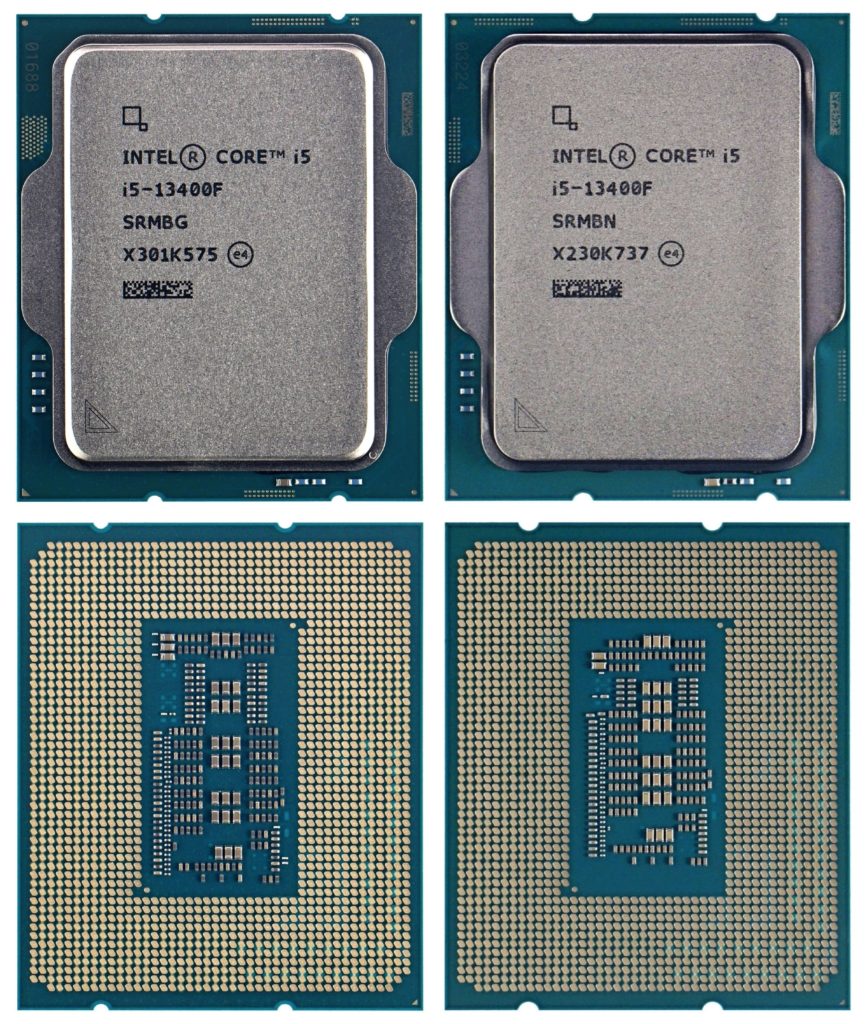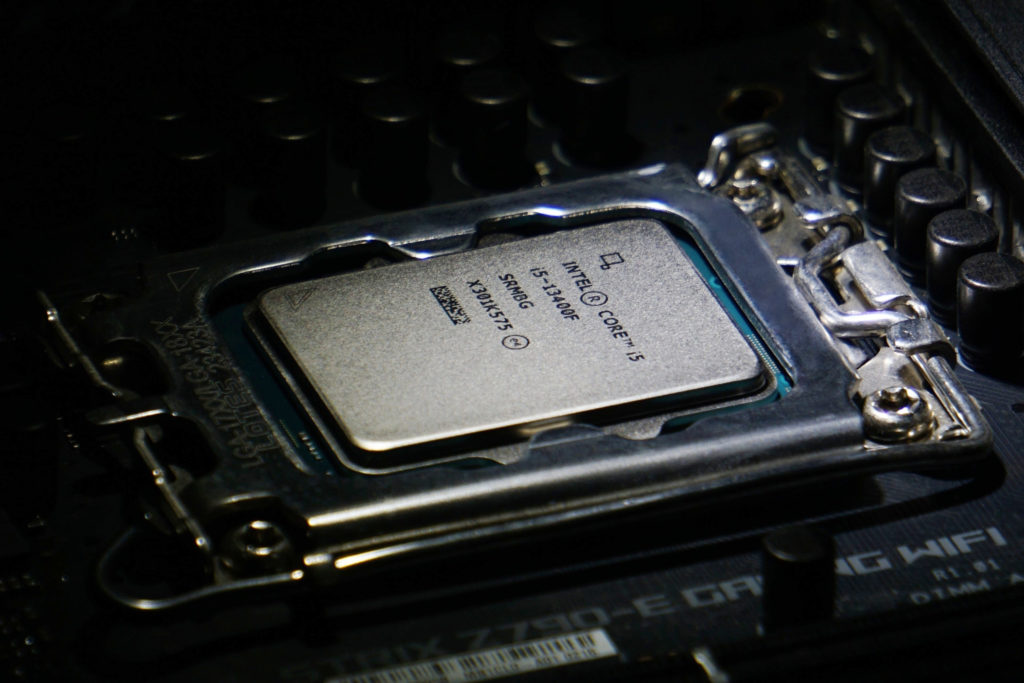Core i5-13400F SRMBG and SRMBN
In the vast majority of Intel Core i5-13400F processor tests (including ours), you’ve studied the results of the variant built on the Golden Cove cores from the Alder Lake generation. But there is also an iteration from Raptor Lake (with Raptor Cove cores). However, this processor is harder to get hold of, its availability is considerably weaker, but it is obtainable. You’ll find out if it’s worth the extra effort from the comparative analysis.
Which Intel Core i5-13400F processor is “better”?
If you’ve purchased a Core i5-13400F processor separately or are about to do so, you’ll most likely come across a variant that physically has a die from the last generation, Alder Lake. The larger one of course, with 8 P cores and 8 E cores natively – stepping C0.
In order to reliably obtain the stepping B0 (with the Raptor Lake die) you would have to really have your eyes set on it. The chances of you getting to this processor by accident are pretty slim. It’s only on sale as a “tray”, that is, without a cooler (just the bare CPU), intended primarily for aftermarket PC vendors. On the retail market, stepping C0 is common, which is already sold as a “box” (with the Intel Laminar RM1 cooler). Its order number is BX8071513400FSRMBN. The „tray“ variant is then CM8071505093005. Stepping B0 is only available in the “tray” variant (with order number CM8071504821107), which is popular especially in the OEM market. The significantly smaller supply of B0 variants will probably be due to the fact that Intel wants to use them as much as possible for more powerful models, and on the contrary, there is a surplus of older Alder Lake (C0) dies, which will not be gotten rid of elsewhere (as in the 65 W Core i5). The Core i3-13100(F) already uses a different die. Also AL, but “H0” (i.e. the smaller one, physically without E cores).
You can also recognize Stepping B0 (Raptor Lake) in a better catalog by the S-Spec code, which is SRMBG. It differs from Stepping C0 (Alder Lake, S-Spec code SRMBN) in the last letter of the designation – “G” instead of “N”. The physical differences, apart from the different markings on the IHS, are visible from the back, where there is a different SMD composition between the contacts. For stepping B0, these components are the same as in the more powerful Raptor Lake processors, and for stepping C0 again as in Alder Lake processors, that is, outside of those with a smaller die with only 6 P cores. CPUs that have the latter are Core i3s and Pentiums, but also the Core i5-12400 stepping H0.
Quite significant differences across steppings (H0 and C0) are also present in Ci5-12400, but in this generation it may be even more interesting. Last time it was about one of the dies being significantly smaller, but still manufactured using the same process (Intel 7). This time the difference in the size of the dies and their native features is quite a bit smaller, but the manufacturing process is different, with stepping B0 being the more modern Intel 7 Ultra. All parameters are otherwise the same, yet these processors may perform differently. And that’s what we’ll focus on in the next pages of the article.

Testing is performed according to standard processor measurement methods. But we don’t go through everything in order and the test set is on the smaller side. It contains those measurements (+ memory tests) in which, in addition to computing or gaming performance, we also record operational characteristics – power draw, temperature and achieved CPU core clock speeds.
Which methods, settings and conditions we use to measure each variable are described in detail in the following links – temperature, core clock speeds and power draw. Regarding power draw, just briefly note that it is measured with current clamps. And just so you don’t have to hunt for key components from other articles, the motherboard is Asus ROG Strix Z790-E Gaming WiFi (BIOS v0502) and the memory is Kingston Fury Beast (2×16 GB, 5200 MHz/CL40) with a 1300 MHz memory controller (Gear 2). The CPU cooler used is the Noctua NH-U14S.
- Contents
- Core i5-13400F SRMBG and SRMBN
- Performance tests
- Memory and cache tests
- CPU power draw curve
- Average CPU power draw
- Achieved CPU clock speeds
- CPU temperature
- Conclusion











Exactly what I feared. The B0 stepping just as other Raptors is overvolted. A bit more power draw, and higher temperatures. The same rule as to the rest of Raptor CPUs applies – their efficiency and heat generation disappoint if you can’t undervolt them, which thanks to our beloved Intel is now almost impossible.
It would be very cool if at least some version of this processor overclocked all cores to 4.6(max boost) at least on some motherboards.
True, Intel could push the all-core boost of the 65W Core i5s (including 13500/F) a bit… the leap from Ci5-13600K will remain very significant (and not cannibalize) even after the 500 MHz boost you suggested for Ci5-13400(F).
sejak kapan ada i5 13500F ?
kalau i5 13500 dan 13500T
itu baru ada.
You’re right. My mistake in the comment, for which I apologize. The 13500F really doesn’t exist (and there is only a 13500). Thanks for pointing it out.
thank you for the information
The hashtag #7nm is wrong, this CPU is 10nm, the process is called Intel 7 probably to mislead customers.
https://www.hwcooling.net/en/intel-core-i9-12900k-megatest-amd-in-2nd-place-again/#comment-2474
Since the CPUIDs of Raptor C0 and Alder C0 are different, there is a possibility that Raptor C0 and Alder C0 are not exactly the same chip.
In that case, the process rules may not be the same either.
(Core i5-8400 and Core i5-9400, which used the same chip, had matching CPUID 906EA)
To make a definitive determination as to whether or not they are the same chip, it is necessary to examine them under an electron microscope.
Raptor B0 (MAX P8 + E16) CPUID B0671
Raptor C0 (MAX P8 + E8) CPUID B06F2
Alder C0 (MAX P8 + E8) CPUID 90672
Alder H0 (MAX P6 + E0) CPUID 90675
That is true. There could be some revision or respin. Personally I expect it’s more likely to be only minor changes though. It could be a change isolated to some metal layer, but perhaps it could even be just a difference in the microcode version that is present on the ship out of the box (I think the base microcode is different, as an effect the 13th generation processors do not work with BCLK OC unlike the 12th gen versions even if they are based on C0 die, for example).
There could also be changes to the manufacturing process even within the original Intel 7 technology. There always are “knobs” that can be tweaked. I think the Ryzen 3000 “XT” refresh CPU were said to have some manufacturing process tweaks and changes, even though it was still all within the envelope of the N7 process tech originally used for prior SKUs.
Something like that could have been done by Intel to these C0 die 13th generation processors, too.